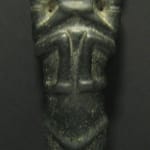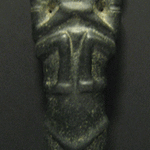Taino Stone Zemi Celt, 1200 CE - 1500 CE
Stone
3.2 x 12.75
BF.044
Further images
The Taino flourished in the Caribbean between c.1200-1500. They were the first Americans to make contact with the Spanish in 1492 and to suffer as a result. Many of the...
The Taino flourished in the Caribbean between c.1200-1500. They were the first Americans to make contact with the Spanish in 1492 and to suffer as a result. Many of the features today associated with the Taino, such as ball-courts and three-pointers (trigonolitos), were first used by their predecessors who migrated to the islands from both South America and Mesoamerica. This highly polished black stone celt is a marvelous example of the artistic capabilities of Taino craftsmen. Undecorated celts served a practical function and were often used as axe heads (the ovoid stones were attached to long wooden shafts for this purpose). The carved examples undoubtedly belonged to the Taino chieftains, or caciques, who utilized them as symbols of authority and wealth.
This example depicts a zemi, the physical manifestation of a god, spirit or ancestor. The Taino were polytheistic and worshipped a number of deities whom they believed controlled the elements, the success of the crops and fertility. Ancestor worship was also important and both the chieftains and shamans claimed to be able to communicate with the dead. This was made possible by inducing a hallucinogenic state through the inhalation of cohoba. Many Taino art-forms depict zemis in skeletal form. This may relate to burial practices among the Taino elite. It was customary for the corpse to be exposed to the elements and the skulls and long bones were then preserved in wooden urns or hung from the rafters of the house. The zemi has square-shaped eye sockets and a wide open mouth. The arms and legs are depicted in the ritual squatting position assumed by shamans during the cohoba ritual. This was clearly an object of considerable spiritual and social significance to its original owners and continues to astound us today. (AM)
This example depicts a zemi, the physical manifestation of a god, spirit or ancestor. The Taino were polytheistic and worshipped a number of deities whom they believed controlled the elements, the success of the crops and fertility. Ancestor worship was also important and both the chieftains and shamans claimed to be able to communicate with the dead. This was made possible by inducing a hallucinogenic state through the inhalation of cohoba. Many Taino art-forms depict zemis in skeletal form. This may relate to burial practices among the Taino elite. It was customary for the corpse to be exposed to the elements and the skulls and long bones were then preserved in wooden urns or hung from the rafters of the house. The zemi has square-shaped eye sockets and a wide open mouth. The arms and legs are depicted in the ritual squatting position assumed by shamans during the cohoba ritual. This was clearly an object of considerable spiritual and social significance to its original owners and continues to astound us today. (AM)







